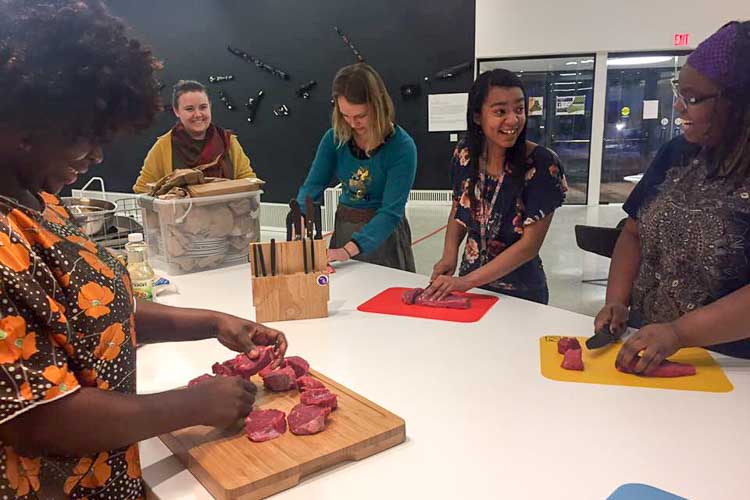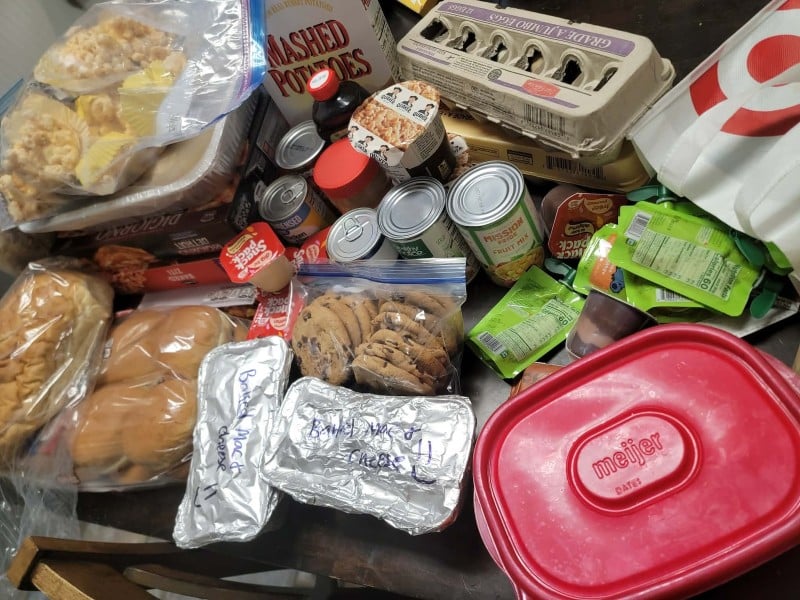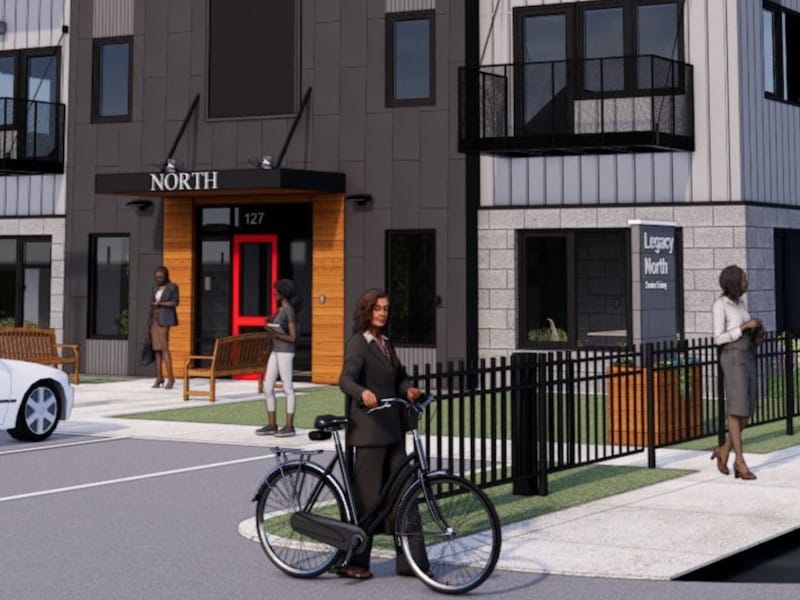What do you do with a big, old church? First Baptist gets creative
Each year thousands of churches have to decide what to do with a building they can no longer fill. First Baptist is working on that.
The way through First Baptist Church is winding and climbs. Starting on the lower level past the spicy smells spilling out of the kitchen, Building Manager Nicholas Baxter leads the way to all his favorite nooks and crannies. Up first one flight, stopping on two more. Peeking into a classroom being used as a gathering space here and a storage closet full of Christmas decorations over there.
What once were Sunday school rooms are now offices for organizations such as the Refugee Outreach Collective, Michigan Festival of Sacred Music, and Kalamazoo Ballet. Crawlspace Eviction Improv Productions, Queer Theater Kalamazoo, Kalamazoo Area Fetal Alcoholism Support Group and Center for Transformations, a religious support group for people returning to society after prison also have moved into the building.
On the third floor is a hydroponic garden. Baxter has learned the chemistry of keeping the plants growing in their indoor environment and the plan is to grow enough for the church’s congregation to eat and sell and to share the produce with homeless people, Loaves & Fishes clients, and those who use the building.
Room by room, the church building is being repurposed to be the home of the Kalamazoo Non-Profit Advocacy Coalition, KNAC, a group that has come together to share the 22,000-square-feet of usable space in the 165-year-old building on Michigan Avenue, one of the original Bronson Park Churches.
Most of those who have agreed to be part of the coalition do not use the space they occupy full-time. Instead, they share it with others so the many rooms in the four-story church can be rented at very low rates. And the price drops for those on the highest levels of the building. About half the church is currently rented out and when the shared-space concept is realized, three or four times as many could fit into the building.
The church also continues to use the building and anticipates other congregations with shrinking numbers may want to share the building, too.
So far, more than 20 organizations or individuals are using the spaces at the church. Together they are tackling a problem facing communities nationwide. As the church-going public divides into those who prefer giant churches and those who want a smaller church, how do you repurpose large church buildings after their congregations no longer need them?
The size of the congregation at First Baptist has been in steady decline for the past 50 years, says Pastor David Nichols. Today about 40 to 50 of the congregations 80 members show up on any given Sunday. “The culture has changed and a number of internal, as well as external things, have led to this,” Nichols says.
When he came to lead the church two-and-a-half years ago the church had almost voted to close—it was three votes short of closing its doors. Nichols quickly found the church was interested in creative alternatives that would allow it to stay open.
“I came out of retirement to come here and look at alternatives,” Nichols says.
The Kalamazoo Non-Profit Advocacy Coalition is not the first idea that emerged, but it is the one that has found traction where the others did not. Nichols says a multicultural center and a health center were both ideas that were floated. “At one point, it looked like a number of these were going to go, and the building was going to be used significantly by these new missions, but then in a matter of a couple of months, they all kind of ground to a halt. They encountered one difficulty after another.”
The church looked for but could not find a group that would be interested in taking over the expense of running the building. Plans started to come together when the idea emerged to turn the building into a community non-profit center. Today Kalamazoo Non-Profit Advocacy Coalition is in the process of forming a 501c3 nonprofit with its own vision. Nathan Dannison, the pastor next door at First Congregational Church, leads the organization.
“We created this organization to say that we want to repurpose buildings, recognizing there are a lot of buildings that are no longer — particularly churches — no longer used for what they originally were,” Nichols says. “And rather than trying to figure out if the best way to proceed to demolish them, or to turn them into housing, we asked if we could we see these buildings being repurposed for the sake of the community.”
The new group also focused on revitalizing organizations. “We felt like there were a number of organizations that would love to be downtown because of the connections here, because of what’s happening downtown, and yet office space is very expensive down here,” Nichols continues. “We said, ‘What if we could offer below-market rental space and do it in a creative way?’ We put together this proposal to do what we call ‘shared space’ so that we have a number of organizations that have come here — almost everybody that’s here right now says they want to use the space at certain times, but at other times, their space can be used by someone else. We can have multiple users for many of our rooms.”
The idea is that by sharing costs organizations could lower their expenses and be revitalized by not having to spend so much of their time and energy raising funds, Nichols says.
Beyond offering a space for community organizations, the KNAC wanted to create one where people would have a place to be heard. The group looked at ways to overcome poverty that went beyond feeding the hungry — though they have that covered, too — and looked for ways to deal with other types of poverty people experience. They considered the existential poverty that people are caught in, Nichols says. “Feeling worthless. Feeling useless. Feeling voiceless. Lacking self-respect. We wanted to know how we can help people in terms of feeding the hungry, but to do it in ways that also give people a voice, give people a sense of dignity and respect, and don’t make them sort of dependent, almost feeling worse about themselves than they would be if they hadn’t gotten any help at all.”
What has emerged has turned out to make sense for the church that has often found itself at the forefront of social change. From its early days, First Baptist has been interested in what’s good for the community. Nichols points to former First Baptist Pastor James Stone and his wife Lucinda who advocated for women to have the same educational opportunities as men around 1843 at a time when such ideas were controversial.
“So the church has always had people associated with it that are very interested in seeing the growth of the community, the wellbeing of the community, and it’s not a simply a matter of saying, ‘How do we as a church grow?’ But rather, ‘How do we make this community a better place?’ So that’s kind of how it all came about.”
Ultimately, Nichols found his time was being taken up with the building rather than the congregation and the decision was made for him to move to part-time so that a building manager could be hired. Baxter says that when he learned of the church and its activities he made persistent visits, questions, calls and insisted upon organizing concerts for the Syrian refugee Orchestra Rouh in the church sanctuary, until he was “given the opportunity to shepherd the church through its transition into becoming a huge hive of non-profit activity and organization as well as a place of diversity, inclusion, and empowerment for the broader community of Kalamazoo.”
In keeping with the coalition concept of the space, the first building user meeting took place Nov. 19. A second meeting is planned Feb. 19. “We’ll bring everyone to get together and talk about what they’re doing in their organizations between each other, and eventually, hopefully, it will harness that and allow it to become some type of social space where everyone can just kind of keep that conversation open,” Baxter says. “And there’s this huge energy of collaboration in the community of Kalamazoo. People that are so active in many different spheres and I think that is very representative of the amount of organizations that are here. The more I can be a bridge between all of these people and allow them to meet, I think that is really going to grow the coalition.”
Nichols says the church is built like a fortress and in 165 years it has had minimal structural problems, but one of the important steps for the building in the coming year will be an assessment of what kinds of structural work may need to be done on the building. A conversation with Kalamazoo City building inspectors to discuss what kinds of regulations the coalition will need to follow as they learn more about how to adapt the building properly. At some point, an elevator will need to be added.
Ideas for the shared space still are emerging — a cafe, a costume lending library, a place for micro-business owners to have an address to collect their mail are some. “We are committed to being very open and creative. We don’t go into these things with a preconceived idea that says this is what we’re going to do, we’re not going to do this,” Nichols says.
“The one thing that I’m certain about with the church is that we really cannot project the future based on our past. We have to be willing to consider new ways of doing things. And know the way society was when this church was founded is simply not the way it is now.”
Kathy Jennings in the managing editor of Southwest Michigan’s Second Wave. She is a freelance writer and editor.


















